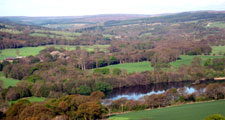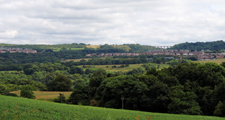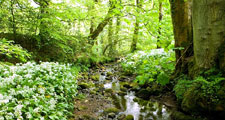Woodland in West Durham Coalfield
Existing Woodland
The pattern and extent of woodland cover varies considerably across the coalfield which is heavily wooded in places and very open in others. Linear ancient semi-natural woodlands lie in denes and steep riverside or valley-side bluffs where they have survived on land too steep for agriculture. Plantations are generally scattered thinly across the valley sides and ridgetops, although there are heavy concentrations in parts of the Browney, Deerness, Derwent, Wear and Pont Valleys. The southern edges of the large Hamsterley Forest also spread onto the coalfield. Secondary semi-natural woodlands are a common feature – including birch woodlands that have naturally colonised marginal upland fringe enclosures and heaths, or woodland sites felled during the Great War. More diverse and variable scrub communities are found on derelict land, abandoned railways lines and road verges.
Native Woods
Oak woods are strongly associated with the acidic and neutral soils of the West Durham Coalfield. Lowland oak woodland communities are found on the more fertile soils of the valleys, being replaced on thinner soils over acid strata in the denes by lowland oak-birch communities. In the upland fringes these give way progressively to their less diverse upland counterparts. Alder-ash communities are found on flushed slopes in dene woodlands. Alder carr woodlands are found on wet fertile soils on the margins of ponds and wetlands and valley fen alderwood on seasonally flooded land along the river. A less common wet woodland type, bay willow woodland, is found on a single site at Causey Bank Mires. Secondary semi natural woodland and scrub communities are typical of derelict land, abandoned railway lines, steep pastures, and the broad verges of enclosure roads. These are highly variable in structure and typically dominated by pioneer species like birch, sycamore, ash, rowan, hawthorn, gorse and dogrose. On wetter ground goat willow, grey willow and eared sallow are common.
Characteristic native woodland types in the West Durham Coalfield (identified here by their National Vegetation Class) include:
- Lowland Oak Woodland – W10
- Upland Oak Birch Woodland – W11
- Lowland Oak Birch Woodland – W16
- Upland Oak Birch Woodland – W17
- Alder Ash Woodland – W7
- Alder Carr Woodland – W5
- Valley Fen Alder Woodland – W6
- Bay Willow Woodland – W3
- Hawthorn Scrub – W21
- Blackthorn Scrub – W22
- Gorse Scrub – W23
- Bramble Scrub – W24/25
Information on the typical structure and species composition of these particular native woodland communities, distribution and guidelines on their management and suitable sites for new planting can be found by clicking on the links above or by downloading the following pdf:
Native Woodland Types (PDF, 598kb)
Native woodlands on the coalfield tend to occur as relatively isolated fragments. Many have been modified by the planting of exotic or commercial species and a number were felled and replanted with conifers in the 1950s and 1960s. While some are managed under WGS contracts – including a number managed by local authorities, the Woodland Trust and the Wildlife Trust, many receive no active management.
Objectives for the area’s existing native woods include:
- Conserving semi-natural woodlands and improving their management.
- Restoring replanted and modified ancient woodlands.
Plantations
Many plantations on the coalfield have their origins in agricultural improvements of the 18th century and 19th century when many new plantations were established on recently enclosed fell land. During the same period many existing parklands were improved or extended and new parklands laid out. Many plantations from this period have been felled and replanted more than once in their history although some older trees, often beech or sycamore, survive. Other plantations were established in the post-war period when substantial areas were planted for taxation purposes on larger estates and a number of ancient woodlands were felled and replanted.
These are usually dominated by softwoods, particularly scots pine and larch, although some contain a proportion of broadleaved species such as beech and oak. Larger plantations including Hamsterley Forest were established in the upland fringes by the Forestry Commission: here sitka spruce is the dominant species. Younger plantations of conifers and native or exotic broadleaved species, varying from large woodlands to narrow shelterbelts and small copses, are a common feature of restored opencast land and reclaimed colliery land.
Many plantations in the area are managed under Woodland Grant Scheme contracts but take-up is very variable. Many plantations receive little active management due to the current economics of forestry. A number of plantations have been planted in recent decades on sites of nature conservation value – particularly lowland or mid-altitude heath. Others – and particularly shelterbelt systems on restored opencast land – have a rather arbitrary relationship with the underlying ridge and valley topography and linear grain of the coalfield landscape.
Objectives for coalfield plantations identified in the Landscape Strategy include restructuring commercial plantations to improve their relationship with the surrounding landscape and to restore damaged habitats like replanted ancient woodlands and planted heaths. Objectives for the area’s plantations include:
- progressive conversion of some softwood plantations to native woodland – and particularly on replanted ancient woodland sites, in denes and riverside bluffs, and sites close to ancient woods, to expand the native woodland habitat resource;
- increasing the proportion of native broadleaved species in softwood plantations – and particularly along watercourses, margins and rides;
- removing planted woodland from sensitive habitats like blanket bog and heathland;
- reshaping woodlands and woodland edges to fit better with the valley topography – and particularly linear shelterbelt systems.
New Woodland
Planting sites
Priorities for new planting in the West Durham Coalfield include:
Creating new native woodlands, and particularly where they would contribute to wildlife goals – for example by extending or linking isolated ancient woods.
As existing semi-natural woods tend to survive as linear features in denes and along watercourses, planting new native woodlands in and around these areas offers the greatest potential for consolidating and linking the woodland habitat network. There may also be merit in planting additional woodlands in heavily wooded areas away from the river corridors to create more robust forest habitat networks in those areas. In selecting sites care needs to be taken to avoid features of value in this landscape – areas of heathland vegetation, old field boundaries, old semi-improved pastures and areas of rig and furrow. Planting new areas of juniper scrub on heaths and fells can help restore what was once a more widespread feature of coalfield heaths.
Increasing woodland cover and particularly in those areas affected by opencast mining, on reclaimed land, and in the urban fringe.
The coalfield landscape as a whole is a priority area for new woodland planting due to its legacy of environmental degradation and its proximity to urban populations. It is a relatively robust and heterogeneous landscape with a long history of plantation forestry that can accommodate new commercial and multi-purpose woodlands as well as new native woodlands without weakening its character. There are some sensitivities in the landscape (see above) but many sites will be suitable for new woodland planting.
Creating new community woodlands close to towns and villages.
The West Durham Coalfield is heavily populated and many towns and villages have little access to woodland or natural green space. Planting community woodlands close to urban populations can provide an important recreational resource for local people as well as improving the appearance of the urban fringe.
Creating new woodlands in the restoration of mineral workings.
The restoration of mineral workings – and particularly opencast coal and brick shale sites – offers opportunities to expand native woodland cover to deliver biodiversity, landscape and community benefits.
In selecting sites for new planting care needs to be taken to avoid features of existing ecological or archaeological value and particularly earthworks like rig and furrow, old semi-improved pasture and meadows, heathland, small scale pre-inclosure field systems and industrial relics.
Planting Design
New woodlands should respect the linear grain of the landscape and where possible follow watercourses, minor valleys and steeper valley slopes. Linear shelterbelts and longer woodland edges running across the contours should be avoided. In areas with strong enclosure patterns, new woodlands should respect and interlock with the surrounding field pattern.
Species Selection
The coalfield has a long tradition of commercial forestry and plantations of both broadleaves and conifers are characteristic features of the landscape. Many of the priorities for new woodland planting are for new native woodlands. For these, existing native woodland types can be used as a guide to species selection.
In the valleys of the coalfield lowland oak woodland communities (W10) are the most appropriate models for new planting on typical agricultural soils, and lowland oak-birch communities (W16) on free draining sandy sites, thin acidic soils, or reclaimed ground. On upland fringe sites their less species-rich upland counterparts (W11, W17) will be more appropriate. Alder communities are well suited to wet ground: W7 on flushed soils, W5 in association with ponds and wetland features, or W6 on land subject to seasonal flooding on river floodplains.
On the more fertile soils of the lower coalfield valleys opportunities may exist for the production of good quality hardwoods with planting mixtures designed for silvicultural purposes. Where possible these should use the native broadleaved species found locally in native woodlands. In parts of the upland fringe, softwood plantations are a more characteristic feature of the local landscape, with Larch and Scots Pine the most commonly planted species. New softwood plantations should include a proportion of locally native broadleaved species and particularly along watercourses, margins and rides.
Further Information
View an interactive map of the distribution of Native Woodland Types in County Durham.



